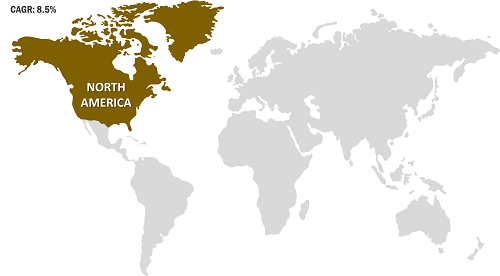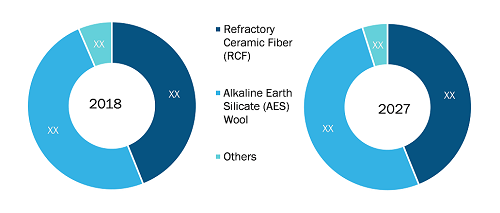The North America ceramic fiber market is accounted to US$ 333.2 Mn in 2018 and is expected to grow at a CAGR of 8.5% during the forecast period 2019 – 2027, to account for US$ 682.8 Mn by 2027.
In 2018, The US is dominating the North America ceramic fiber market, followed by Canada. The power generation sector is an important consumer of ceramic fiber due to its wide utilization of insulation. In commercial fire protection, ceramic fibers are used in grease-duct insulation and penetration and expansion-joint seals. Ceramic fiber products are used in refractories for high-temperature equipment that is used in ceramic production. This equipment includes blast furnaces, hot stoves, steam boilers, cement kilns, glass tanks, and open-hearth furnaces. The wide application of ceramic fiber is boosting demand in the US.
North America Ceramic Fiber Market

- This FREE sample will include data analysis, ranging from market trends to estimates and forecasts.
Market Insights
Growing Demand from Various End-Use Industries
The lightweight of ceramic fiber is an essential feature that weighs about one-tenth as compared to insulating brick and one third than that of calcium silicate or asbestos boards. For new constructions, the structural supports can be reduced to approximately 40% with the help of ceramic fibers. Another important feature that has been responsible for the increasing demand from the end-users is lower heat storage. Due to its lower density, ceramic fiber absorbs less heat due to which the furnaces can be heated and cooled at much faster rates. Thermal shock resistance is another contributing factor for the increasing demand for ceramic fiber market. Due to its resilient matrix, ceramic fiber linings are capable of resisting thermal shock. All these properties of ceramic fiber have been contributing to the growing demand for ceramic fiber from various end-use industries like iron and steel, refining and petrochemical, power generation, aluminum, and others.
Type Insights
Based on type, the North America ceramic fiber market is bifurcated as Refractory Ceramic Fiber (RCF), Alkaline Earth Silicate (AES) wool, and others. The RCF segment holds the largest share in the North America ceramic fiber market. RCFs are manufactured in various forms, such as bulk fiber, blanket, modules, felt, paper, and vacuum formed shapes. Products made of RCF products are used in industrial equipment, fire protection, and automotive exhaust systems. Refractory ceramic fiber (RCF) has been recognized as the first-choice material in several end-use industries. They are easy to handle and possess low thermal conductivity and heat capacity. Apart from this, they possess superior resistance to thermal shock and pollutants; and can withstand extreme temperatures. Such qualities of RCF make it a viable product for numerous applications. They are mainly used as a lining material for kilns and furnaces and as an insulator for the outside of the ceramic molds. They are also extensively used for insulation in condensing boilers and as the sealing material in various industries such as mechanical, metallurgical, power, and chemical industries.
Product Form Insights
Based on product form, the North America ceramic fiber market is bifurcated as a blanket, module, board, paper, and others. The blanket segment dominated the North America ceramic fiber market. Blankets find their applications in a number of industries which incorporates temperatures from 1000°F (538°C) to 2600°F (1425°C). They are also used in petrochemical, steel, ceramic, and power generation as heat shields, seals and gaskets, pipe and ducting wrap, steam turbine insulation, pipe insulation, exhaust lining, fire protection systems amongst others. Ceramic fiber blankest offers resistance to thermal shock and oxidizing and exhibits low thermal conductivity and heat storage along with good dielectric strength, superior resiliency, non-combustibility, and sound absorption.
End-Use Industry Insights
The North America Ceramic fiber market is bifurcated based on the end-use industry into iron and steel, refining and petrochemical, power generation, aluminum, and others. The refining and petrochemical segment accounted for the largest share in the North America ceramic fiber market. Ceramic fibers possess several properties, such as lightweight, resistance to thermal shock, chemical & corrosion, low thermal conductivity, and high-temperature stability. Also, low operational costs, high reliability, and less energy requirement associated with the use of ceramic fiber in furnace linings, roofs, and walls are boosting its usage across the refining and petrochemical industry.
US Ceramic Fiber Market by Type

- This FREE sample will include data analysis, ranging from market trends to estimates and forecasts.
NORTH AMERICA CERAMIC FIBER MARKET SEGMENTATION
North America Ceramic Fiber Market – By Type
- Refractory Ceramic Fiber (RCF)
- Alkaline Earth Silicate (AES) Wool
- Others
North America Ceramic Fiber Market – By Product Form
- Blanket
- Module
- Board
- Paper
- Others
North America Ceramic Fiber Market – By End-Use Industry
- Iron and Steel
- Refining and Petrochemical
- Power Generation
- Aluminum
- Others
North America Ceramic Fiber Market – By Country
- US
- Canada
- Mexico
Company Profiles
- Great Lakes Textiles
- HarbisonWalker International, Inc.
- 3M
- Lewco Specialty Products, Inc.
- Luyang Energy-Saving Materials Co., Ltd.
- Morgan Advanced Materials
- Nutec Group
- Pyrotek Inc.
- Rath-Group
North America Ceramic Fiber Report Scope
| Report Attribute | Details |
|---|---|
| Market size in 2018 | US$ 333.2 Million |
| Market Size by 2027 | US$ 682.8 Million |
| CAGR (2019 - 2027) | 8.5% |
| Historical Data | 2016-2017 |
| Forecast period | 2019-2027 |
| Segments Covered |
By Type
|
| Regions and Countries Covered |
North America
|
| Market leaders and key company profiles |
|
- Historical Analysis (2 Years), Base Year, Forecast (7 Years) with CAGR
- PEST and SWOT Analysis
- Market Size Value / Volume - Regional, Country
- Industry and Competitive Landscape
- Excel Dataset
Recent Reports
Testimonials
Reason to Buy
- Informed Decision-Making
- Understanding Market Dynamics
- Competitive Analysis
- Identifying Emerging Markets
- Customer Insights
- Market Forecasts
- Risk Mitigation
- Boosting Operational Efficiency
- Strategic Planning
- Investment Justification
- Tracking Industry Innovations
- Aligning with Regulatory Trends






















 Get Free Sample For
Get Free Sample For